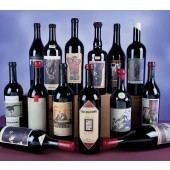 | ||
Sine Qua Non (also known as SQN) is a California cult winery known for its Rhône style blends, a tendency to avoid repetition, and a very limited production of wine that is highly difficult to obtain, with 100% of all releases allocated and directly sold to a carefully managed mailing list. The mailing list has by some measures a five- to ten-year waiting list. The winery is located in Ventura County, within the Central Coast AVA.
The wines have been titled with names such as Queen of Spades, Twisted & Bent, Imposter McCoy, The Bride, Poker Face, and Red Handed, and the bottles come uncommonly shaped with distinctive labels featuring Manfred Krankl's own artwork.
History
Founded in 1994 by Manfred Krankl and his wife Elaine. The Krankls began making their own wines in 1994 due to personal interest and with the added benefit of being able, if the wines were good enough, to sell them to the successful Mediterranean-themed Los Angeles restaurant Campanile, which Manfred co-founded and managed. Beginning with several self described "project wines" made in partnership with John Alban and other vintners, initial production was approximately 100 cases. After several experiments with white varietals, Rhone red varietals and even Pinot noir, the Krankls found their sweet spot in 1994 with a predominantly Syrah-based blend they named Queen of Spades that earned a 95 point rating from Robert Parker. Today, this wine retails at an average price of $5,861 per bottle.
Manfred was also a co-founder of La Brea Bakery. Sale of a portion of his ownership position in LaBrea enabled him to focus on wine-making full-time, at which point total production, diversity of releases, and competency with the full spectrum of Rhone (and other) varietals steadily increased.
Sourcing fruit from a wide variety of growers from year to year, and increasingly from their own vineyards has caused the winery to never make exactly the same wine twice, about which Krankl has said, "People buy Sine Qua Non. They don’t seem to give a toot where it’s from".
A tradition at Sine Qua Non is that each wine has a distinct name, label and often bottle style. Each label is hand made by Manfred with linocut art work of his own creation. This process requires each year's wine's names and labels to be individually approved by the United States Bureau of Alcohol, Tobacco, Firearms and Explosives, an unpredictable process subject to the whims and vagaries of regulators. Despite numerous and seemingly random rejections, Krankl has persisted with this expensive and time consuming process, creating a colorful, diverse and oftentimes humorous body of label art.
Sine Qua Non's Syrahs were among the first American Syrahs to create significant interest and trading volume in the worldwide wine auction market. From the second quarter of 1999 to early 2008, the value of SQN wines at auctions appreciated by 163% in contrast to the 128% appreciation rate during the same period of other collectible wines listed on the Wine Spectator Auction Index. By 2015 three half bottles of the 2002 Rosé (not normally a variety that attracts high prices at auction) sold for $4,200.
Sine Qua Non's first winery, located in a nondescript warehouse at the back of an industrial facility in North Ventura, has been described by Robert Parker as "a facility that looks like a Mad Max movie set". Over the years the Krankls have steadily purchased or leased their own terroir with the goal of obtaining total control over the growth and supply of their grapes. Currently they manage several vineyards including an approximately 10 planted acre plot at their home facility in Oakview, CA, just inland from Ventura, CA, and another approximately 20 planted acre plot in the Santa Rita Hills region near Buellton, CA. In 2012 a major new winery facility was completed on the Krankl's Oak View, CA lands and most vinification was relocated there from the initial Ventura winery location.
In collaboration with Austrian winemaker Alois Kracher, Manfred and Elaine Krankl have also produced sweet wines under the label "Mr. K" (after the surnames of the two winemakers). Krankl announced that this program would end with the release of the 2006 vintage due to the untimely passing of Kracher.
The red wines have typically included the grape varieties of Syrah, Grenache and Mourvedre. The white wines are typically made from Roussanne, Viognier and Marsanne. Sine Qua Non also produced a Pinot noir for several years, but discontinued that program after the 2005 vintage. In certain vintages, the winery has also release a rosé made predominantly from the Grenache varietal.
In the late 2000s, Sine Qua Non began releasing Syrah and Grenache blends with extended barrel aging (EBA). These wines are held in barrel or cask for at least two and sometimes up to six years prior to bottling and release.
The annual production of Sine Qua Non averages 3,500 cases (310 hL), or approximately one hundred and forty standard sixty gallon barrels, a quantity the Krankls call the maximum possible given their non-scalable, personal, hands-on tending of the entire winemaking process, including literally each vine and cluster of grapes in all vineyards from which they derive fruit.
